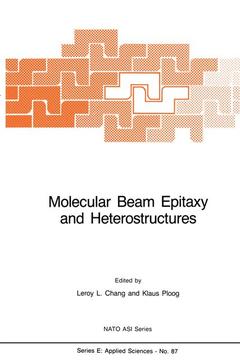Description
Molecular Beam Epitaxy and Heterostructures, Softcover reprint of the original 1st ed. 1985
NATO Science Series E: Series, Vol. 87
Coordinators: Chang L.L., Ploog K.
Language: English
Keywords
alloy; dynamics; semiconductors; surface science; thermodynamics
Publication date: 10-2011
728 p. · 15.5x23.5 cm · Broché
728 p. · 15.5x23.5 cm · Broché
The NATO Advanced Study Institute on "Molecular Beam Epitaxy (MBE) and Heterostructures" was held at the Ettore Majorana Center for Scientific Culture, Erice, Italy, on March 7-19, 1983, the second course of the International School of Solid-State Device Re search. This volume contains the lectures presented at the Institute. Throughout the history of semiconductor development, the coupling between processing techniques and device structures for both scientific investigations and technological applications has time and again been demonstrated. Newly conceived ideas usually demand the ultimate in existing techniques, which often leads to process innova tions. The emergence of a process, on the other hand, invariably creates opportunities for device improvement and invention. This intimate relationship between the two has most recently been witnessed in MBE and heterostructures, the subject of this Institute. This volume is divided into several sections. Chapter 1 serves as an introduction by providing a perspective of the subject. This is followed by two sections, each containing four chapters, Chapters 2-5 addressing the principles of the MBE process and Chapters 6-9 describ ing its use in the growth of a variety of semiconductors and heteros tructures. The next two sections, Chapters to-II and Chapters 12-15, treat the theory and the electronic properties of the heterostructures, respectively. The focus is on energy quantization of the two dimensional electron system. Chapters 16-17 are devoted to device structures, including both field-effect transistors and lasers and detec tors.
1. Semiconductor Superlattices and Quantum Wells through Development of Molecular Beam Epitaxy.- Molecular Beam Epitaxy (MBE) Process.- 2. Kinetic and Surface Aspects of MBE.- 3. The Application of Thermodynamics to Molecular Beam Epitaxy.- 4. Some Aspects of Surface Science Related to MBE.- 5. Molecular Beam Epitaxial III-V Compounds: Dopant Incorporation, Characteristics and Behavior.- Growth and Properties of Semiconductors.- 6. Growth and Properties of III-V Semiconductors by Molecular Beam Epitaxy.- 7. MBE Growth of II-VI and IV-VI Compounds and Alloys.- 8. Silicon Molecular Beam Epitaxy.- 9. Molecular Beam Epitaxial Growth and Characterization of III-V/III-V and IV/III-V Heterostructures.- Theory of Heterostructures.- 10. Theory of Heterojunctions: A Critical Review.- 11. Envelope Function Approach to the Superlattice Band Structure.- Electronic Properties of Heterostructures.- 12. Light Scattering in Semiconductor Heterostructures.- 13. Electronic Properties of Semiconductor Heterostructures in a Magnetic Field.- 14. Modulation Doping of Semiconductor Heterostructures.- 15. Doping Superlattice.- Heterostructure Devices.- 16. Semiconductor Lasers and Photodetectors by Molecular Beam Epitaxy.- 17. Modulation Doped AlxGa1-xAs/GaAs Field Effect Transistors (MODFET): Analysis, Fabrication and Performance.- Alternative Epitaxy.- 18. Metal Organic Chemical Vapor Deposition.
© 2024 LAVOISIER S.A.S.




